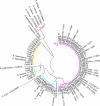Comparison of the identification of coagulase-negative staphylococci by matrix-assisted laser desorption ionization time-of-flight mass spectrometry and tuf sequencing
- PMID: 21359622
- PMCID: PMC3172412
- DOI: 10.1007/s10096-011-1204-3
Comparison of the identification of coagulase-negative staphylococci by matrix-assisted laser desorption ionization time-of-flight mass spectrometry and tuf sequencing
Abstract
The increasing incidence of coagulase-negative staphylococci (CoNS) in hospital-acquired infections underlines the need for an accurate and simple identification of Staphylococcus isolates at the species level. Sequencing of the tuf gene has been shown to be the most accurate for the species identification of CoNS. We determined the species of 62 consecutive clinical and 31 reference CoNS isolates by tuf gene sequencing and matrix-assisted laser desorption ionization time-of-flight mass spectrometry (MALDI-TOF-MS). Species assignment by MALDI-TOF-MS and tuf sequencing was congruent in all cases. We conclude that MALDI-TOF-MS is accurate for identifying CoNS in routine clinical practice. The study also identified an unexpectedly high number of cases of Staphylococcus capitis infections among 62 consecutive CoNS isolates in 2009 at the University Medical Center Utrecht, the Netherlands.
Figures

References
-
- Hidron AI, Edwards JR, Patel J, Horan TC, Sievert DM, Pollock DA, Fridkin SK. NHSN annual update: antimicrobial-resistant pathogens associated with healthcare-associated infections: annual summary of data reported to the National Healthcare Safety Network at the Centers for Disease Control and Prevention, 2006–2007. Infect Control Hosp Epidemiol. 2008;29:996–1011. doi: 10.1086/591861. - DOI - PubMed
-
- Spanu T, De Carolis E, Fiori B, Sanguinetti M, D’Inzeo T, Fadda G, Posteraro B. Evaluation of matrix-assisted laser desorption ionization-time-of-flight mass spectrometry in comparison to rpoB gene sequencing for species identification of bloodstream infection staphylococcal isolates. Clin Microbiol Infect. 2011;17:44–49. doi: 10.1111/j.1469-0691.2010.03181.x. - DOI - PubMed
Publication types
MeSH terms
Substances
LinkOut - more resources
Full Text Sources
Medical

